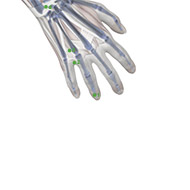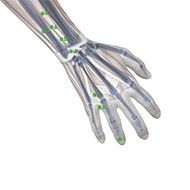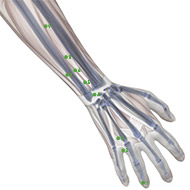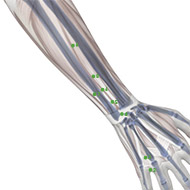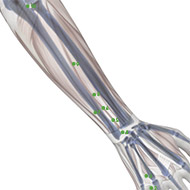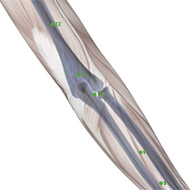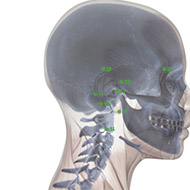The meridian system (simplified Chinese: 经络; traditional Chinese: 經絡; pinyin: jīngluò, also called channel network) is a concept in Traditional Chinese medicine (TCM) about a path through which the life-energy known as “qi” flows.1 The twelve standard meridians, also called principal meridians, are divided into Yin and Yang groups. The Yin meridians of the arm are Lung, Heart, and Pericardium. The Yang meridians of the arm are Large Intestine, Small Intestine, and Triple Burner. The Yin Meridians of the leg are Spleen, Kidney, and Liver. The Yang meridians of the leg are Stomach, Bladder, and Gall Bladder.2 The Sanjiao Meridian or Sanjiao Channel is one of the 12 principal meridians in TCM. It corresponds with the Jueyin Pericardium Meridian of the Hand. The Flow Hours of this meridian are 9:00 PM – 11:00 PM.3
CONTENTS
ORGAN AND FUNCTION
ACUPOINTS
FLOWING ROUTES
ORGAN AND FUNCTION
In TCM, the Sanjiao is a yang organ paired with the pericardium (Xin Bao), which is the yin organ associated with it. Yang (Fu) organs are typically hollow, whereas yin (Zang) organs are more solid. The triple burner, however, is said to be primarily energetic and does not have a physical component, unlike all the other organs in TCM. In dissecting a body, one would not be able to find a structure that could be called the Sanjiao. The Sanjiao’s Hand-Foot partner is Dan (Gall Bladder).4 It has the following principal functions:
It is said to be a metabolism mechanism similar to an old-fashioned water wheel, that is turned by incoming water and creates energy for accomplishing a task, such as grinding grain in the case of the water wheel, or for metabolising and digesting food in the case of the Sanjiao. The Sanjiao is closely associated with the spleen functions of transformation and transportation, particularly the metabolism of incoming food. It is also closely associated with the kidney’s function in TCM.5 The Sanjiao, however, is not limited to one metabolism function as the spleen or kidneys are, but is a general metaboliser which can be applied to a variety of metabolism needs.6
ACUPOINTS
This meridian contains 23 acupoints in one side, that is 46 acupoints in total.
TB-1
Location: On the lateral side of the ring finger, about 0.1 cun from the corner of the nail.
Indications: Headache, redness of the eyes, sore throat, stiffness of the tongue, febrile diseases, irritability.
Acupuncture Method: Puncture superficially 0.1 inch, or prick with a three-edged needle to cause bleeding. Moxibustion is applicable.
Vasculature: The arterial and venous network formed by the palmar digital proprial artery and vein.
Innervation: The palmar digital proprial nerve derived from the ulnar nerve.
TB-2
Location: When the fist is clenched, the point is located in the depression proximal to the margin of the web between the ring and small fingers, at the junction of the red and white skin.
Indications: Headache, redness of the eyes, sudden deafness, sore throat, malaria, pain in the arm.
Acupuncture Method: Puncture obliquely 0.3-0.5 inch towards the interspace of the metacarpal bones. Moxibustion is applicable.
Vasculature: The dorsal digital artery of the ulnar artery.
Innervation: The dorsal branch of the ulnar nerve.
TB-3
Location: When the fist is clenched, the point is on dorsum of the hand between the fourth and fifth metacarpal bones, in the depression proximal to the fourth metacarpophalangeal joint.
Indications: Headache, redness of the eyes, deafness, tinnitus, sore throat, febrile diseases, pain in the elbow and arm, motor impairment of fingers.
Acupuncture Method: Puncture perpendicularly 0.3-0.5 inch. Moxibustion is applicable.
Vasculature: The dorsal venous network of hand and the fourth dorsal metacarpal artery.
Innervation: The dorsal branch of the ulnar nerve.
TB-4
Location: On the transverse crease of the dorsum of wrist, in the depression lateral to the tendon of m. extensor digitorum communis.
Indications: Pain in the arm, shoulder and wrist, malaria, deafness, thirst.
Acupuncture Method: Puncture perpendicularly 0.3-0.5 inch. Moxibustion is applicable.
Vasculature: The dorsal venous network of the wrist and the posterior carpal artery.
Innervation: The terminal branch of the posterior antebrachial cutaneous nerve and the dorsal branch of the ulnar nerve.
TB-5
Location: 2 cun proximal to the dorsal crease of the wrist, on the line connecting Yangchi (TB-4) and the tip of olecranon, between the radius and ulna.
Indications: Febrile diseases, headache, pain in the cheek, strained neck, deafness, tinnitus, pain in the hypochondriac region, motor impairment of the elbow and arm, pain of the fingers, hand tremor.
Acupuncture Method: Puncture perpendicularly 0.5-1.0 inch. Moxibustion is applicable.
Vasculature: Deeper, the posterior and anterior antebrachial interosseous arteries and veins.
Innervation: The posterior antebrachial cutaneous nerve; deeper, the posterior interosseous nerve and the anterior interosseous nerve.
TB-6
Location: 3 cun proximal to the dorsal crease of the wrist, on the line connecting Yangchi (TB-4) and the tip of olecranon, between the radius and ulna, on the radial side of m. extensor digitorum.
Indications: Tinnitus, deafness, pain in the hypochondriac region, vomiting, constipation, febrile diseases, aching and heavy sensation of the shoulder and back, sudden hoarseness of voice.
Acupuncture Method: Puncture perpendicularly 0.8-1.2 inches. Moxibustion is applicable.
Regional anatomy: See Waiguan (TB-5).
TB-7
Location: At the level with Zhigou (TB-6), on the ulnar side of Zhigou (TB-6), on the radial border of the ulna.
Indications: Deafness, pain in the ear, epilepsy, pain of the arm.
Acupuncture Method: Puncture perpendicularly 0.5-1.0 inch. Moxibustion is applicable.
Vasculature: The posterior antebrachial interosseous artery and vein.
Innervation: The posterior and medial antebrachial cutaneous nerves; deeper, the posterior and anterior interosseous nerves.
TB-8
Location: 4 cun proximal to the dorsal crease of the wrist, between the radius and ulna.
Indications: Deafness, sudden hoarseness of voice, pain in the chest and hypochondriac region, pain in the hand and arm, toothache.
Acupuncture Method: Puncture perpendicularly 0.5-1.0 inch. Moxibustion is applicable.
Regional anatomy: See Huizong (TB-7).
TB-9
Location: On the lateral side of the forearm, 5 cun below the olecranon, between the radius and ulna.
Indications: Deafness, toothache, migraine, sudden hoarseness of voice, pain in the forearm.
Acupuncture Method: Puncture perpendicularly 0.5-1.0 inch. Moxibustion is applicable.
Regional anatomy: See Huizong (TB-7).
TB-10
Location: When the elbow is flexed, the point is in the depression about 1 cun superior to the olecranon.
Indications: Migraine, pain in the neck, shoulder and arm, epilepsy, scrofula, goiter.
Acupuncture Method: Puncture perpendicularly 0.3-0.5 inch. Moxibustion is applicable.
Vasculature: The arterial and venous network of the elbow.
Innervation: The posterior brachial cutaneous nerve and the muscular branch of the radial nerve.
TB-11
Location: 1 cun above Tianjing (TB-10) when the elbow is flexed.
Indications: Motor impairment and pain of the shoulder and arm, migraine.
Acupuncture Method: Puncture perpendicularly 0.3-0.5 inch. Moxibustion is applicable.
Vasculature: The terminal branches of the median collateral artery and vein.
Innervation: The posterior brachial cutaneous nerve and the muscular branch of the radial nerve.
TB-12
Location: On the line joining the olecranon and Jianliao (TB-14), midway between Qinglengyuan (TB-11) and Naohui (TB-13).
Indications: Headache, neck rigidity, motor impairment and pain of the arm.
Acupuncture Method: Puncture perpendicularly 0.5-0.7 inch. Moxibustion is applicable.
Vasculature: The median collateral artery and vein.
Innervation: The posterior brachial cutaneous nerve and the muscular branch of the radial nerve.
TB-13
Location: On the line joining Jianliao (TB-14) and the olecranon, on the posterior border of m. deltoideus.
Indications: Goiter, pain in the shoulder and arm.
Acupuncture Method: Puncture perpendicularly 0.5-0.8 inch. Moxibustion is applicable.
Vasculature: The median collateral artery and vein.
Innervation: The posterior brachial cutaneous nerve, the muscular branch of the radial nerve; deeper, the radial nerve.
TB-14
Location: On the shoulder, posterior to Jianyu (LI-15), in the depression inferior and posterior to the acromion when the arm is abducted.
Indications: Pain and motor impairment of the shoulder and upper arm.
Acupuncture Method: Puncture perpendicularly 0.7-1.0 inch. Moxibustion is applicable.
Vasculature: The muscular branch of the posterior circumflex humeral artery.
Innervation: The muscular branch of the axillary nerve.
TB-15
Location: Midway between Jianjing (GB-21) and Quyuan (SI-13), on the superior angle of the scapula.
Indications: Pain in the shoulder and elbow, stiffness of the neck.
Acupuncture Method: Puncture perpendicularly 0.3-0.5 inch. Moxibustion is applicable.
Vasculature: The descending branch of the transverse cervical artery; deeper, the muscular branch of the suprascapular artery.
Innervation: The accessory nerve and the branch of the suprascapular nerve.
TB-16
Location: On the lateral side of the neck, directly below the posterior border of mastoid process, on the level of the mandibular angle, and on the posterior border of sternocleido mastoid muscle.
Indications: Headache, neck rigidity, facial swelling, blurring of vision, sudden deafness.
Acupuncture Method: Puncture perpendicularly 0.3-0.5 inch. Moxibustion is applicable.
Vasculature: The posterior auricular artery.
Innervation: The lesser occipital nerve.
TB-17
Location: Posterior to the lobule of the ear, in the depression between the mandible and mastoid process.
Indications: Tinnitus, deafness, otorrhea, facial paralysis, toothache, swelling of the cheek, scrofula, trismus.
Acupuncture Method: Puncture perpendicularly 0.5-1.0 inch. Moxibustion is applicable.
Vasculature: The posterior auricular artery and vein, the external jugular vein.
Innervation: The great auricular nerve; deeper, the site where the facial nerve perforates out of the stylomastoid foramen.
TB-18
Location: In the centre of the mastoid process, at the junction of the middle and lower third of the curve formed by Yifeng (TB-17) and Jiaosun (TB-20) posterior to the helix.
Indications: Headache, tinnitus, deafness, infantile convulsion.
Acupuncture Method: Puncture subcutaneously 0.3-0.5 inch or prick with a three-edged needle to cause bleeding. Moxibustion is applicable.
Vasculature: The posterior auricular artery and vein.
Innervation: The posterior auricular branch of the great auricular nerve.
TB-19
Location: Posterior to the ear, at the junction of the upper and middle third of the curve formed by Yifeng (TB-17) and Jiaosun (TB-20) behind the helix.
Indications: Headache, tinnitus, deafness, pain in the ear, infantile convulsion.
Acupuncture Method: Puncture obliquely 0.3-0.5 inch. Moxibustion is applicable.
Vasculature: The posterior auricular artery and vein.
Innervation: The anastomotic branch of the great auricular nerve and the lesser occipital nerve.
TB-20
Location: Directly above the ear apex, within the hair line.
Indications: Tinnitus, redness, pain and swelling of the eye, swelling of gum, toothache, parotitis.
Acupuncture Method: Puncture subcutaneously 0.3-0.5 inch. Moxibustion is applicable.
Vasculature: The branches of the superficial temporal artery and vein. Innervation: The branches of the auriculotemporal nerve.
TB-21
Location: In the depression anterior to the supratragic notch and behind the posterior border of the condyloid process of the mandible. The point is located with the mouth open.
Indications: Tinnitus, deafness, otorrhea, toothache, stiffness of the lip.
Acupuncture Method; Puncture perpendicularly 0.3-0.5 inch. Moxibustion is applicable.
Vasculature: The superficial temporal artery and vein.
Innervation: The branches of the auriculotemporal nerve and facial nerve.
TB-22
Location: Anterior and superior to Ermen (TB-21), at the level with the root of the auricle, on the posterior border of the hairline of the temple where the superficial temporal artery passes.
Indications: Migraine, tinnitus, lockjaw.
Acupuncture Method: Avoid puncturing the artery, puncture obliquely 0.1-0.3 inch. Moxibustion is applicable.
Vasculature: The superficial temporal artery and vein.
Innervation: The branch of the auriculotemporal nerve, on the course of the temporal branch of the facial nerve.
TB-23
Location: In the depression at the lateral end of the eyebrow
Indications: Headache, redness and pain of the eye, blurring of vision, twitching of the eyelid, toothache, facial paralysis.
Acupuncture Method: Puncture subcutaneously 0.3-0.5 inch.
Vasculature: The frontal branches of the superficial temporal artery and vein.
Innervation: The zygomatic branch of the facial nerve and the branch of the auriculotemporal nerve.
FLOWING ROUTES
This meridian originates from the ulnar side of the tip of the ring finger (Guanchong, TB-1) and runs upwards along the dorsum of the wrist to Yangchi (TB-4). Running upwards between the ulna and the radius, it passes through the olecranon and runs along the lateral side of the upper arm to the shoulder region where it moves forward into the supraclavicular fossa (Quepen, ST-12) and spreads in the chest to link with the pericardium. Then, it descends through the diaphragm to successively distribute in the upper, middle and lower energizer. One branch from Danzhong (CV-17) runs upwards and emerges from the supraclavicular fossa (Quepen, ST-12). Then, it reaches the shoulder and the back of the neck (Dazhui, GV-14) where it crosses and meets its opposite branch. From there, it ascends to the neck and runs along the posterior border of the ear (Yifeng, TB-17), reaching the region superior to the apex of the ear. Further, it turns downward to the cheek and terminates in the infraorbital region. Another branch separating from retroauricular region enters the ear. Then emerging along the anterior aspect of the ear in front of Shangguan (GB-3), it crosses the previous branch at the cheek and reaches the outer canthus (Tongziliao, GB-1) to connect with shaoyang gallbladder meridian of foot.7
Footnotes
- What Is Traditional Chinese Medicine – sciencebasedmedicine.org – 2012, https://sciencebasedmedicine.org/what-is-traditional-chinese-medicine/
- Advanced Pressure Point Fighting of Ryukyu Kempo – A Dillman Karate International Book – 1994, https://www.amazon.com/Advanced-Pressure-Point-Fighting-Ryukyu/dp/0963199633/
- Acupuncture points of the Sanjiao meridian of the hand – cnacupuncture.com – 2017, http://www.cnacupuncture.com/points-of-triple-energizer-meridian-of-hand-shaoyang.html
- Chinese natural cures – Black Dog & Leventhal Publishing – 1994, https://www.abebooks.com/book-search/isbn/1579120563/
- The foundations of chinese medicine: a comprehensive text for acupuncturists and herbalists – Black Dog & Elsevier Churchill Livingstone – 2005, https://www.amazon.com/Foundations-Chinese-Medicine-Comprehensive-Acupuncturists/dp/0443074895
- Chinese acupuncture and moxibustion – Foreign Languages Press – 1987, https://www.amazon.com/Chinese-Acupuncture-Moxibustion-Seventeenth-Printing/dp/7119059947/ref=sr_1_1?s=books&ie=UTF8&qid=1493125663&sr=1-1
- Sanjiao meridian of the hand – tcmwiki.com – 2017, https://tcmwiki.com/wiki/shaoyang-sanjiao-meridian-of-hand
LU01
LU02
LU03
LU04
LU05
LU06
LU07
LU08
LU09
LU10
LU11
LI01
LI02
LI03
LI04
LI05
LI06
LI07
LI08
LI09
LI10
LI11
LI12
LI13
LI14
LI15
LI16
LI17
LI18
LI19
LI20
ST01
ST02
ST03
ST04
ST05
ST06
ST07
ST08
ST09
ST10
ST11
ST12
ST13
ST14
ST15
ST16
ST17
ST18
ST19
ST20
ST21
ST22
ST23
ST24
ST25
ST26
ST27
ST28
ST29
ST30
ST31
ST32
ST33
ST34
ST35
ST36
ST37
ST38
ST39
ST40
ST41
ST42
ST43
ST44
ST45
SP01
SP02
SP03
SP04
SP05
SP06
SP07
SP08
SP09
SP10
SP11
SP12
SP13
SP14
SP15
SP16
SP17
SP18
SP19
SP20
SP21
HT01
HT02
HT03
HT04
HT05
HT06
HT07
HT08
HT09
SI01
SI02
SI03
SI04
SI05
SI06
SI07
SI08
SI09
SI10
SI11
SI12
SI13
SI14
SI15
SI16
SI17
SI18
SI19
BL01
BL02
BL03
BL04
BL05
BL06
BL07
BL08
BL09
BL10
BL11
BL12
BL13
BL14
BL15
BL16
BL17
BL18
BL19
BL20
BL21
BL22
BL23
BL24
BL25
BL26
BL27
BL28
BL29
BL30
BL31
BL32
BL33
BL34
BL35
BL36
BL37
BL38
BL39
BL40
BL41
BL42
BL43
BL44
BL45
BL46
BL47
BL48
BL49
BL50
BL51
BL52
BL53
BL54
BL55
BL56
BL57
BL58
BL59
BL60
BL61
BL62
BL63
BL64
BL65
BL66
BL67
KD01
KD02
KD03
KD04
KD05
KD06
KD07
KD08
KD09
KD10
KD11
KD12
KD13
KD14
KD15
KD16
KD17
KD18
KD19
KD20
KD21
KD22
KD23
KD24
KD25
KD26
KD27
PC01
PC02
PC03
PC04
PC05
PC06
PC07
PC08
PC09
TB01
TB02
TB03
TB04
TB05
TB06
TB07
TB08
TB09
TB10
TB11
TB12
TB13
TB14
TB15
TB16
TB17
TB18
TB19
TB20
TB21
TB22
TB23
GB01
GB02
GB03
GB04
GB05
GB06
GB07
GB08
GB09
GB10
GB11
GB12
GB13
GB14
GB15
GB16
GB17
GB18
GB19
GB20
GB21
GB22
GB23
GB24
GB25
GB26
GB27
GB28
GB29
GB30
GB31
GB32
GB33
GB34
GB35
GB36
GB37
GB38
GB39
GB40
GB41
GB42
GB43
GB44
LV01
LV02
LV03
LV04
LV05
LV06
LV07
LV08
LV09
LV10
LV11
LV12
LV13
LV14
GV01
GV02
GV03
GV04
GV05
GV06
GV07
GV08
GV09
GV10
GV11
GV12
GV13
GV14
GV15
GV16
GV17
GV18
GV19
GV20
GV21
GV22
GV23
GV24
GV25
GV26
GV27
GV28
CV01
CV02
CV03
CV04
CV05
CV06
CV07
CV08
CV09
CV10
CV11
CV12
CV13
CV14
CV15
CV16
CV17
CV18
CV19
CV20
CV21
CV22
CV23
CV24



